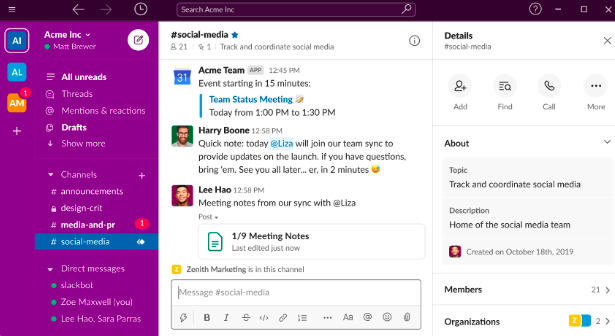Managing a remote team is tough, and you need to figure out the right way to lead.
Charismatic leadership can be a powerful approach that can increase employee productivity, drive higher performance and unite a globally-distributed team members toward common goals.
At NoHQ, we have the resources you need to develop an effective leadership style as a remote worker. This article will explore what a charismatic leader is and how to develop these attributes.
What is Charismatic Leadership?
Charismatic leadership is characterized by the leader’s ability to use personal charm, persuasiveness and other compelling qualities to influence those they lead. The leader channels positive qualities to develop trust, admiration and loyalty among followers.
Charismatic leadership was first recognized as an effective form of leadership 100 years ago by German sociologist Max Weber, who hypothesized that people follow leaders when they perceive their authority as just. This inherent trust and reliance is the essence of charismatic leadership.
Many influential people throughout history have embraced this leadership style. Some examples of charismatic leaders include Mahatma Gandhi, Barack Obama, and Winston Churchill, and Reverend Martin Luther King Junior.
Why Charismatic Leadership is Important for an Organization’s Success
Charismatic leadership is particularly important for companies with global teams, which face unique challenges due to physical separation. It can be difficult for employees working from locations across the world to remain unified, motivated, and in sync with the organization’s goals and vision.
A charismatic leader can help address and repair these roadblocks by building trust, boosting morale, and creating strong channels of communication. By rallying employees around a central point (the leader), the team becomes more unified. This is particularly helpful for employees who are physically removed from the organization and struggle to feel connected to other team members.
While people can achieve success individually, the greatest success is accomplished under the direction of an influential leader. Charismatic leaders maintain a clear vision of where the organization is headed and have a defined sense of purpose, which they continually promote.
Characteristics of charismatic leaders
While many of us have heard the term “natural-born leader,” it is a somewhat misleading phrase. It’s easy to assume that many of history’s most charismatic leaders were born ready to lead, but studies show that many of the qualities possessed by charismatic leaders are not necessarily inherent but can be developed. According to an article featured in Forbes, half of the qualities that comprise charisma are trained, while only half are innate.
So, what qualities make up a charismatic leader? Although there are many, here we have highlighted a few:
- Vision: Charismatic leaders have a unique ability to maintain a long-term view of the future, where they want the organization to go, and how to achieve it. And, just as importantly, charismatic leaders know how to effectively communicate this vision to the people they lead.
- Confidence: Confidence is the bread and butter of charismatic leadership. It is the subtle, powerful quality of inner strength and self-assurance that draws people to the leader and creates a sense of trust and loyalty.
- Communication: Effective, persuasive communication is one of the most powerful ways that charismatic leaders not only form positive relationships with their employees, but successfully maintain them.
How to Become an Effective Charismatic Leader
1. Practice active communication with your remote team
A. Master remote communication: Learning to communicate remotely is different. Much of remote communication is asynchronous, meaning there is a gap between the message and response. This can lead to miscommunications and employees who are less than informed. Ensuring that remote employees feel heard and that team members are on the same page is challenging. Some useful tips include:
- Embracing asynchronous communication as a primary form of communication in the workplace
- Adopting a remote-first approach, which involves taking extra measures to document communication and allow time for asynchronous communication to occur before moving forward with decisions
B. Utilize various communication tools: Using a range of online tools naturally encourages more frequent communication and allows employees to communicate in the way they are most comfortable. Some examples include:

- Slack
- Notion
- Microsoft Teams (video calls, IM, etc.)
Explore NoHQ’s wealth of recommended communication tools, articles and guides to develop the best remote communication strategy for your organization.
C. Set communication expectations while also adapting to different communication styles: While a certain level of communication is non-negotiable, accommodating different styles of communication, especially if you need to interact with them regularly. Otherwise, this can lead to communication issues with various members of your team.
D. Set regular team meetings and one on ones: Scheduling frequent meeting times to touch base on projects, coordinate goals, and discuss deadlines and other concerns will foster relationships and trust with the people you lead. It also helps minimize the likelihood of miscommunications and associated problems.
2. Develop your confidence
A. Overcome imposter syndrome: Imposter syndrome is the belief that your accomplishments and success are the result of fraud or happenstance. Approximately 70% of people are expected to experience imposter syndrome at some point in life. Taking steps to overcome these feelings will help you develop greater confidence. It’s vital to recognize your success is due to your own efforts and that you are enough.
B. Improve your public speaking skills: People are naturally drawn to leaders who are powerful orators. Luckily, it’s a skill you can learn through repeated practice, the use of conversational language, and concise expression of your message.
C. Build a foundation of confidence: There are steps you can take to actively increase your self-confidence. Some examples of these steps include:
- Avoiding comparing yourself to other people
- Choosing to speak kindly to yourself
- Limiting your interactions with negative people
- Actively engaging in positive thinking
- Taking time for self-reflection
3. Rally around goals
Focus on uniting the people you lead around common goals. Some ideas include:
- Setting goals that are both specific and measurable
- Choosing goals that are a reach, but achievable
- Making a detailed plan to achieve the agreed-upon goals
4. Practice regular vision-setting
Creating a specific vision for where you want your company to arrive in the future is crucial for maintaining team unity as a charismatic leader. Taking advantage of the data available to you to make data-driven decisions can justify decisions you make now with the intent of ultimately reaching a greater end.
5. Reframe failures and develop growth mindset
An essential characteristic for a charismatic leader to develop is the ability to glean positivity from failure. Recognizing that failures happen and are opportunities to learn makes the work environment feel safer for employees and gives them greater opportunities to take appropriate risks without judgment or fear of failure.
In the face of failure, a charismatic leader avoids maintaining a fixed mindset and instead embraces a growth mindset, which centers on the belief that mistakes provide positive lessons and the opportunity to improve.
6. Develop new leaders
Although charismatic leaders produce successful outcomes, you need to balance this out with other types of leadership that are less focused on individuals. As charismatic leadership centers on a particular leader and their attributes, it is risky to rely fully on one individual.
Expanding leadership styles in the organization prevents the possibility of harmful outcomes occurring when followers become too invested in one person.
The Advantages and Disadvantages of Charismatic Leadership in a Remote Workplace
When practiced correctly, charismatic leadership can be an effective tool for your remote business. But when channeled incorrectly, it can have destructive results. To demonstrate this, let’s take a look at a historical example:
Adolf Hitler was the epitome of a charismatic leader. A skilled orator and uncannily persuasive, he gained an unprecedented following in Germany in the 1920s and 1930s. He rose to power rapidly, becoming one of the most popular leaders in Germany’s history. Because of their inherent trust in Hitler, many Nazi followers adopted the “ends justify the means” mindset, leading them to commit unspeakable travesties.
Below, we’ve broken down some of the advantages and disadvantages of charismatic leadership:
Charismatic Leadership Advantages
- Can increase motivation, productivity, and performance among employees
- Promotes unity and collaboration, leading to better organizational outcomes among remote teams
- Can lead to better engagement from employees
- Builds momentum and creates room for significant, positive change in the company
Charismatic Leadership Disadvantages
- Can result in inflated ego and narcissism
- The leader can become overly self-invested. If the leader gains too much clout, they may choose to place their own interests above the interests of the organization
- Not everyone can relate to this leadership style; may come across as disingenuous
- Runs the risk of too much power and emotional investment in a single person
Conclusion
Charismatic leadership is one of the most powerful ways to motivate and unite remote employees, enhance productivity and produce higher company performance. By practicing the skills outlined in this post, you can develop the required skills to become an effective charismatic leader and ultimately lead your organization to achieve greater success.
Check out NoHQ for more articles, inspiration and resources for successfully running your remote business.
